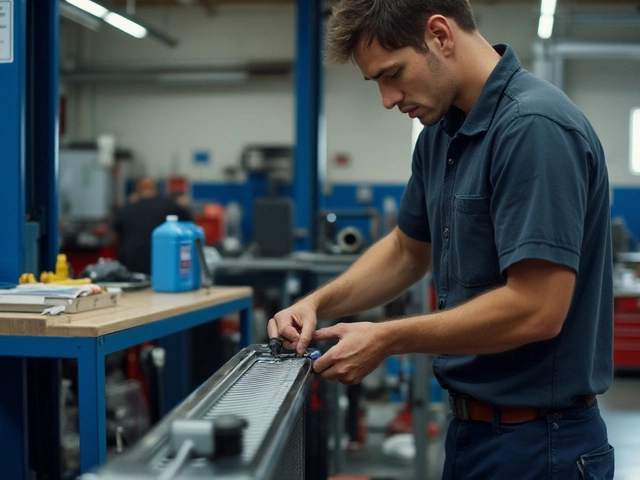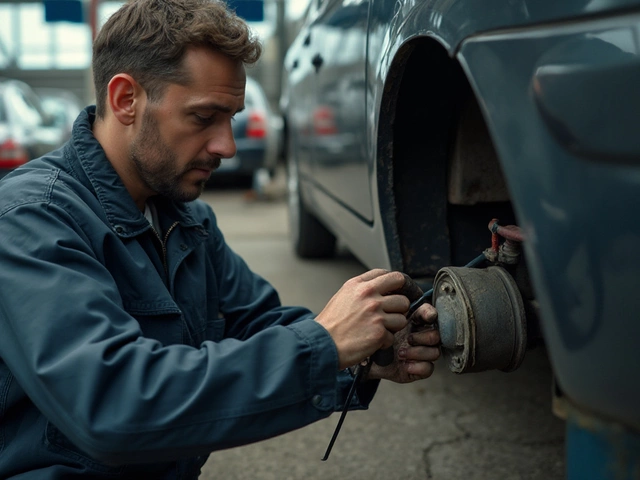In the symphony of road noise, strange sounds can often act as a telltale sign that your vehicle needs a little attention. One such noise that can be particularly concerning is the distinct clatter or rattle of a loose strut. Recognising this sound is crucial for ensuring your car's suspension system continues to handle the rigors of daily driving smoothly.
A strut is more than just a part of your vehicle's suspension system—it's integral to your car's ability to absorb shocks and maintain a steady drive. When something goes awry, it can lead to a cascade of unnatural sounds and sensations. For the untrained ear, these can sometimes blend into the background hum of daily commutes, only drawing attention when the problem worsens.
This guide aims to equip you with the knowledge needed to pinpoint those pesky noises accurately and act on them before they evolve into more significant issues. From understanding what struts do to identifying their problematic sounds, we cover it all in this down-to-earth, easy-to-follow guide. Dive in to keep your travels safe and your mind at ease.
- Recognising the Signs
- Understanding Strut Function
- Common Sounds from a Loose Strut
- Tips for Troubleshooting and Repair
Recognising the Signs
A loose strut in your vehicle’s suspension can often be a mysterious culprit responsible for a host of unusual noises and driving discomforts. Understanding what a loose strut sounds like is vital for any car owner, as early detection can prevent minor issues from snowballing into costly repairs. Typically, one of the first signs that might alert you to a problem is a persistent clunking sound emanating from your car’s wheel area, especially when you hit a bump or a pothole. This sound is a telltale sign that your strut isn’t securely fastened, allowing unwanted movement.
In addition to unfamiliar sounds, changes in the vehicle's handling can also be a significant indicator of strut issues. A car that previously enjoyed a smooth ride might suddenly feel bouncy or unsteady, particularly when negotiating corners or making sudden stops. This loss of control and stability is not only uncomfortable but could also pose safety hazards if left unchecked. Conduct a simple driveway test by pressing down firmly on one corner of your car: if it continues to bounce up and down, the strut might be the issue at hand.
While immediate sounds and handling issues are the most evident signs, visual cues can also offer clues. Inspect your car's tires regularly; uneven or premature tire wear could point to suspension troubles, with struts being highly probable suspects. A close look under the vehicle can sometimes reveal visible oil leaks around the suspension components, indicative of a damaged strut. In instances where struts have severely degraded, rust or corrosion might also become apparent, compromising the entire suspension system's integrity.
"The repeated clunking noise often starts quietly, growing more persistent with time," says the technical director of Car Service International, noting how often overlooked signs can lead to larger problems.
Delving further into maintenance insights, it’s suggested that vehicle owners take heed of manufacturer guidelines regarding suspension checks, typically recommended every 50,000 miles. Those frequently driving on less-than-ideal road conditions may need more frequent inspections. Keeping a maintenance log can help track any emerging patterns of noises or handling issues, ensuring that nothing gets swept under the rug until it's too late.
| Sign | Possible Issue |
|---|---|
| Clunking Noise | Loose or damaged strut |
| Uneven Tire Wear | Suspension misalignment |
| Excessive Bounce | Weak strut absorption |
| Oil Leak | Strut seal failure |
It’s crucial to remember that these symptoms apply to a range of suspension components and not solely to struts. Therefore, if you're not absolutely certain about self-diagnosing, consulting with a qualified mechanic is a reasonable step. Keeping both ears and eyes alert for these signals not only preserves the health of your car but also ensures you travel safe, day after day. So, next time your vehicle generates more than just the usual motor hum, don’t dismiss it as a minor inconvenience. Your attention to these signs could mean the difference between a minor fix and a major repair bill down the road.

Understanding Strut Function
The world of automotive mechanics is filled with components and systems, each tirelessly working to ensure a smooth drive. One such element is the trusty strut, a pivotal player in your car's suspension system. At the heart of its function lies the ability to absorb the myriad shocks and vibrations from the road, helping maintain stability and control. A bit like an orchestra conductor, it harmonizes the interplay between the road surface and the chassis, ensuring that both the wheels and the frame dance gracefully over the bumps and troughs of the journey.
To dive a little deeper, a car's strut typically combines the shock absorber and coil spring into a single integrated unit. This ingenious design not only saves space but also brings efficiency in controlling the ride dynamics. As the vehicle traverses various terrains, the strut absorbs shocks from the uneven surfaces, dampening the vibrations before they resonate through the cabin. It's the guardian that shields passengers from the jarring feel of potholes or rough patches, contributing significantly to driving comfort and the car's handling.
The sturdiness and efficiency of struts can't be undervalued. They not only support the vehicle's height, acting as load bearers, but also ensure that the tires remain in contact with the road at all times. This constant contact allows for better steering and braking performance, critical components of driving safety. An insightful quote from the esteemed automotive publication,
"A well-functioning strut is like having a brand-new pair of shoes; it gives you confidence and ensures you reach your destination securely,"captures the essence of what a reliable strut means to the vehicle's dynamics.
While most vehicles rely on the classic MacPherson strut design, variations exist, adapting to different sizes and performance needs across the automotive spectrum. Keeping a keen eye on the strut's health is vital. Damage or wear can slowly diminish its capability, leading to excessive body roll, uneven tire wear, or even longer stopping distances. Regular maintenance checks can preempt many of these issues, securing peace of mind as you tackle the open road.
To encapsulate the critical role of strut function within the spectrum of car maintenance, consider its evolutionary journey. The modern strut is an engineering marvel that has evolved over decades, meticulously designed to integrate seamlessly with modern car architectures. As cars become faster and safer, the need for a reliable suspension system, anchored by the strut, grows ever more significant. Understanding its function not only equips you with the knowledge to address potential issues but enriches your appreciation for the nuanced dance of mechanics each time you hit the road.

Common Sounds from a Loose Strut
Understanding the nuances of car noise can often feel like trying to decipher a second language. A loose strut, an integral part of the suspension system, can create a range of unusual sounds. Knowing these sounds can help differentiate between a minor annoyance and a potentially severe issue lurking beneath your vehicle's surface. One of the more common noises is a clunking sound, often described as a metal-on-metal impact. This usually becomes most noticeable over bumps, potholes, or rough roads where the vehicle's suspension system is under stress.
Clunking isn't the only noise a loose strut might produce. Another sound to be on the lookout for is creaking, which may occur as the strut's components move during turns or when maneuvering at slower speeds. This can give the impression of an old wooden floorboard, although the source stems from worn-out strut mounts or rubber bushings. The recurrence of this sound can be particularly frustrating in a traffic-laden city like Manchester, where stop-and-go driving is commonplace.
A high-pitched squeaking might also accompany the strut problems. This is usually caused by a lack of lubrication between parts and can be exacerbated by humid weather conditions. This noise often varies in volume depending on vehicle speed and road conditions, adding another layer of complexity to pinpointing the source. With squeaking, it's crucial to remember that even if the sound doesn't seem loud, it can indicate significant wear that could influence handling and ride comfort. According to a publication by AutoCar, "Undiagnosed suspension issues are among the leading causes of compromised vehicle safety, often starting with innocuous noises."
To better visualize the types of sounds and their conditions of occurrence, consider this illustrative table:
| Sound Type | Common Occurrence | Possible Cause |
|---|---|---|
| Clunking | Driving over bumps | Loose/broken mount |
| Creaking | Turning at low speed | Worn-out bushings |
| Squeaking | Frequent low speed | Lack of lubrication |
Each sound presents a unique clue into what might be ailing your vehicle's suspension system. Identifying these auditory hints and correlating them with driving conditions can significantly aid in diagnosing the precise location and nature of the problem. This can help in deciding whether you can address the issue yourself or whether it might be time for professional intervention. An early diagnosis not only saves money but also ensures safe driving conditions, preventing potentially hazardous driving scenarios caused by a deteriorating suspension system.

Tips for Troubleshooting and Repair
When it comes to diagnosing and fixing a loose strut in your vehicle, the process begins with a careful assessment of the symptoms. The first step is to listen closely. Any unusual noises, such as clunks or rattles especially when driving over uneven surfaces, can be indicative of strut issues. Begin your troubleshooting by driving your car in a safe area free of significant outside noise. Try to replicate the conditions under which the noise most frequently occurs. Identify whether the sound occurs during acceleration, deceleration, or when navigating sharp bends.
Once the noise source has been pinpointed, visually inspect the suspension system. Look for signs of wear such as rust, cracked or damaged rubber insulators, and leaks from hydraulic fluid in the struts. These can be telltale signs of malfunction which, if not addressed, could worsen over time. Make use of a flashlight to get a clearer view of dark or obscured areas. Ensure the car is on a stable surface and properly supported by jack stands if you're conducting an undercarriage inspection.
For a more precise assessment, consider the bounce test. This involves physically pressing down on the corners of your car and releasing. A functioning suspension should ideally bounce back into position quickly. If any part of the car continues to bounce for several rebounds, it indicates suspension issues, possibly involving the struts. Additionally, a steering wheel that feels uncharacteristically loose or vibrations that intensify at higher speeds can also signify related problems.
If you're not confident in your ability to conduct repairs, consulting with a professional mechanic is advisable. Not only can they provide a definitive diagnosis, they may also offer efficient repairs backed by experience. Many garages now use advanced diagnostic tools to ensure they pinpoint the issue accurately. Also, remember that vehicle maintenance is an ongoing process. Regular checks can preempt the need for more extensive repairs.
Should you opt for self-repair, ensure you have the correct tools and replacement parts. A typical repair might involve replacing the struts entirely if they are damaged beyond adjustment or repair. Utilize service manuals specific to your vehicle model for precise instructions. In the process of repair, keep track of all bolts, nuts, and components to ensure accurate reassembly. It’s a challenging task for a first-timer, but with patience and attention to detail, it can certainly be done.
“A stitch in time saves nine,” advises the RAC in one of their recent guides on suspension maintenance. By addressing small issues promptly, you can prevent costly repairs down the line.
It’s also helpful to note down any observations as you work, as a comprehensive record of symptoms and steps taken can aid future diagnoses, either by yourself or professionals. Being vigilant about car suspension issues doesn't just extend the life of your vehicle, it enhances safety and driving comfort, which ultimately translates into a smoother ride every time you hit the road.


